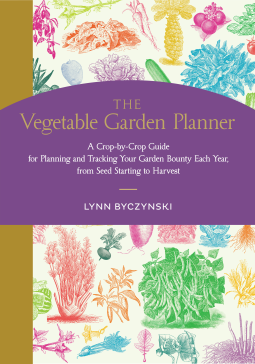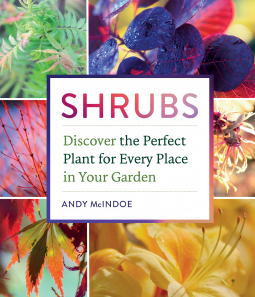Book Review: The Vegetable Garden Planner: A Crop-by-Crop Guide for Planning and Tracking Your Garden Bounty Each Year, from Seed Starting to Harvest by Lynn Byczynski
Early Book Review: Growing an Edible Landscape: How to Transform Your Outdoor Space into a Food Garden by Gary Pilarchik; Chiara D'Amore
Growing an Edible Landscape: How to Transform Your Outdoor Space into a Food Garden by Gary Pilarchik; Chiara D'Amore is currently scheduled for release on November 28 2023. Out with the lawn and in with the food! That’s the battle cry of millions of modern gardeners who are not only looking to reduce the amount of time and energy they have to spend tending a lawn, but they’re also looking to improve the lives of their family, friends, and neighbors by supplying them with fresh, homegrown food. Converting unused areas of the landscape into food gardens helps mitigate the effects of climate change, reduces food miles, improves food security, and allows us to be a better steward of our little slice of the planet. But how do you get started? Which plants do you choose? Is there a series of best practices to follow to successfully convert your yard into an edible oasis so that it’s not just high-yielding, but it’s also attractive? Growing an Edible Landscape is here to help answer all of these questions and many more.
Early Book Review: The 30-Minute Gardener: Cultivate Beauty and Joy by Gardening Every Day by Greg Loades
Early Book Review: Tiny and Wild: Build a Small-Scale Meadow Anywhere by Graham Laird Gardner
Book Review: Tea Gardening for Beginners: Learn to Grow, Blend, and Brew Your Own Tea At Home by Julia Dimakos
Early Book Review: Weed-Free Gardening: A Comprehensive and Organic Approach to Weed Management by Tasha Greer
Weed-Free Gardening is a well written and organized book. I found that it could stand up well to reading cover to cover or by reading the sections you need most or want to study up on. I like that the suggestions and explanations are realistic and understandable. I liked that the author acknowledged that no solution is perfect, because nature is amazing and every yard, region, and gardener is a little different. However, I loved that the history, science, and personal stories are woven in together to give readers the best foundation of information to figure out what they want to try, what is most likely to suit their needs, and how to adjust as they try things. I thought the information was clearly worded, easy to follow and understand, and paired with images that brought it all together. I was just planning this year's garden, and this book has given me some great ideas and helped to shift some of my gardening notions that just might have been part of my weed issues. I look forward to trying out some of the new tips and tricks that are now part of my knowledge base. I wish I had more room on my gardening bookshelf so I could add it to my collection. I just might splurge on a copy even though I am out of room.
Early Book Review: Gardening for Everyone: Growing Vegetables, Herbs, and More at Home by Julia Watkins
Book Review: Attracting Beneficial Bugs to Your Garden, Second Edition: A Natural Approach to Pest Control by Jessica Walliser
Early Book Review: Lavender: 50 Self-Care Recipes and Projects for Natural Wellness by Bonnie Louise Gillis
Lavender: 50 Self-Care Recipes and Projects for Natural Wellness by Bonnie Louise Gillis is currently scheduled for release on April 27 2021. The book covers gardening (favorite varieties and pollinators); preserving (harvesting, drying, and extracting culinary oil); body care (essential oils, aromatherapy, oral remedies); the mind (stress relief and sleep); skin care (including allergens); cleaning (antiseptic and antifungal properties); food (pantry essentials); and projects (including gifts). In the simple herbal remedies, tips, and projects for inspiration, relaxation and well-being you will find recipes for: Lavender Matcha Latte, Yoga Mat Freshening Mist, Dried Lavender Fire-Starter, Lavender Frosé, Day's End Tea, Blue Day Lavender Roll-Away, Nourishing Lavender Makeup Remover, Lavender and Rose Fizzy Bath Salts, Sweet Dreams Diffuser Oil, and a Soothing Eye Pillow.
Lavender is a well organized and written book that offers readers exactly that the title promises. I found the tone and wording to be very easy to follow- making things simple for those new to the subject comfortable while not making more experienced lavender lovers feel talked down to or bored. I think the book offers a well rounded explanation of all things lavender, and that it will be a valuable tool for those that want to grow their own lavender and make simple (or more complex) things for themselves with this versatile plant. I certainly plan on planting some more and making a few new things after reading this book. It is a great resource for those just getting started, and those that want to refine their use of lavender or try a few new things.
Early Book Review: 100 Plants to Feed the Monarch: Create a Healthy Habitat to Sustain North America's Most Beloved Butterfly by The Xerces Society
100 Plants to Feed the Monarch: Create a Healthy Habitat to Sustain North America's Most Beloved Butterfly by The Xerces Society is currently scheduled for release on April 13 2021. The plight of the monarch butterfly has captured public attention and sparked widespread interest in helping to save their dwindling populations. In this in-depth portrait of the monarch butterfly—covering its life cycle, its remarkable relationship with milkweed, its extraordinary migration, and the threats it now faces due to habitat loss and climate change—detailed instructions on how to design and create monarch-friendly landscapes are enriched by guidance on observing and understanding butterfly behavior and habits. Following the model of their previous best-selling book, 100 Plants to Feed the Bees, the Xerces Society provides at-a-glance profiles of the plant species that provide monarchs with nourishment. The plants, which are all commercially available, range from dozens of species of milkweed—the only food of monarch caterpillars—to numerous flowering plants, shrubs, and trees that provide nectar for the adult butterfly, including those that bloom in late season and sustain monarchs in their great migration. Gorgeous photographs of monarchs and plants, plus illustrations, maps, and garden plans, make this a visually engaging guide.
Book Review: Gardening to Eat: Connecting People and Plants by Becky Dickinson
Early Book Review: Grow Your Own Tea: The Complete Guide to Cultivating, Harvesting, and Preparing by Christine Parks; Susan M. Walcott
Book Review: Grow in the Dark: How to Choose and Care for Low-Light Houseplants by Lisa Eldred Steinkopf
Early Book Review: Mini Meadows: Grow a Little Patch of Colorful Flowers Anywhere around Your Yard by Mike Lizotte
Shrubs: Discover the Perfect Plant for Every Place in Your Garden by Andy McIndoe
Early Book Review: Gardening with Emma; Grow and Have Fun A Kid to Kid Guide by Emma Biggs, Steven Biggs
Book Review: Countertop Gardens: Easily Grow Kitchen Edibles Indoors for Year-Round Enjoyment by Shelley Levis
Book Review: Dig In: 12 Easy Gardening Projects Using Kitchen Scraps by Kari Cornell, Jennifer S. Larson
Early Book Review: Gardening Under Lights: The Complete Guide for Indoor Growers by Leslie F Halleck
 Gardening Under Lights: The Complete Guide for Indoor Growers by Leslie F Halleck is currently scheduled for release on July 11 2018. This book is a resource that gives information on just about everything a gardener or hobbyist needs to know to garden indoors. Part One of the book starts with the basics of photosynthesis, the science of light, and how to accurately measure how much light a plant needs. Part Two gives an overview of the most up-to-date tools and gear available. Parts Three and Four offer tips and tools for growing popular ornamental and edible plants independent of the constraints of volatile outdoor conditions.
Gardening Under Lights: The Complete Guide for Indoor Growers by Leslie F Halleck is currently scheduled for release on July 11 2018. This book is a resource that gives information on just about everything a gardener or hobbyist needs to know to garden indoors. Part One of the book starts with the basics of photosynthesis, the science of light, and how to accurately measure how much light a plant needs. Part Two gives an overview of the most up-to-date tools and gear available. Parts Three and Four offer tips and tools for growing popular ornamental and edible plants independent of the constraints of volatile outdoor conditions. 




















